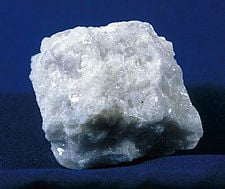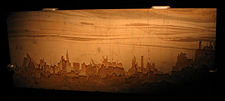Difference between revisions of "Marble" - New World Encyclopedia
(→Cultural associations: added text) |
|||
| Line 12: | Line 12: | ||
== Cultural associations == | == Cultural associations == | ||
| − | As the favorite medium for [[Greece|Greek]] and [[Roman Empire|Roman]] sculptors and architects, marble has become a cultural symbol of tradition and refined taste. | + | As the favorite medium for [[Greece|Greek]] and [[Roman Empire|Roman]] sculptors and architects, marble has become a cultural symbol of tradition and refined taste. In folklore, marble is associated with the astrological sign of [[Gemini]]*. Pure white marble is a symbol of purity and immortality. It is also considered an ensurer of success in education. |
| − | + | The extremely varied and colorful patterns of marble make it a favorite decorative material. These patterns are often imitated, such as in "paper marbling," a technique for producing colorful swirls on paper. Marble patterns are also evident in backgrounds for computer displays. | |
==Origins== | ==Origins== | ||
| Line 42: | Line 42: | ||
Places named after the stone include Marble Hill in Manhattan, New York; the [[Sea of Marmara]]*; [[India]]'s Marble Rocks; the towns of Marble in Minnesota and Colorado; and Marble Arch in [[London]]. The Elgin Marbles are marble sculptures from the [[Parthenon]]* (ancient Greek temple) that are on display in the British Museum. | Places named after the stone include Marble Hill in Manhattan, New York; the [[Sea of Marmara]]*; [[India]]'s Marble Rocks; the towns of Marble in Minnesota and Colorado; and Marble Arch in [[London]]. The Elgin Marbles are marble sculptures from the [[Parthenon]]* (ancient Greek temple) that are on display in the British Museum. | ||
| − | == | + | == Sculptural uses == |
| + | |||
| + | [[Sculpture]] is among the oldest of the arts, and sculptures rank among the greatest of human achievements. Marble sculpture is the [[art]] of creating three-dimensional forms from marble. | ||
| + | |||
| + | Limestone can have fluid patterns of mineral staining, usually gray to black. The finest marbles for sculpture have no or few stains (some natural stain can be seen in the sculpture shown at left, which the sculptor has skillfully incorporated into the sculpture). | ||
| + | |||
| + | ===Advantages=== | ||
| + | |||
| + | Among the commonly available stones only marble has a slight surface translucency that is comparable to that of human [[skin]]. It is this translucency that gives a marble scuplture a visual depth beyond its surface and this evokes a certain realism when used for figurative works. Marble also has the advantage that when first quarried it is relatively soft and easy to work, refine, and polish. As the finished marble ages it becomes harder and more durable. Preference to the cheaper and less translucent [[limestone]] is based largely on the fineness of marble's grain, which enables the sculptor to render minute detail in a manner not always possible with limestone; it is also more weather resistant. | ||
| + | |||
| + | ===Disadvantages=== | ||
| + | |||
| + | Marble does not bear handling well as it will absorb skin oils when touched, which leads to yellow to brownish staining. While more resistant than limestone it is subject to attack by weak acids, and so performs poorly in outdoor environments subject to [[acid rain]]. For severe environments, [[granite]] is a more lasting material but one which is far more difficult to work and much less suitable for refined works such as those shown here. | ||
| + | |||
| + | Compared to metals such as [[bronze]], marble lacks ductility and strength, requiring special structural considerations when planning a sculpture. In the scupture shown to the right, the figure can be placed upon slender lower legs and the balls of the feet only because the bending stress in the sculpture is taken through the flowing drapery of the skirt, which is founded upon an upthrust portion of the ground and with the feet forms a tripod-like foundation for the mass. For comparison see some of the examples in the article concerning [[bronze sculpture]] (especially the sculpture [[:Image:Jeté - Statue by Enzo Plazzotta - Millbank - Westminster - London - 240404.jpg|''Jeté'']]) for the ease with which ''action'' and ''extension'' may be expressed. | ||
| + | |||
| + | ==Commercial uses of marble== | ||
Colorless marbles are a very pure source of [[calcium carbonate]]*, which is used in a wide variety of industries. Finely ground marble powder is a component in [[paint]]s, [[toothpaste]], and [[plastic]]s. Calcium carbonate can also be reduced under high heat to [[calcium oxide]] (also known as "lime"), which has many applications, including being a primary component of most cements. | Colorless marbles are a very pure source of [[calcium carbonate]]*, which is used in a wide variety of industries. Finely ground marble powder is a component in [[paint]]s, [[toothpaste]], and [[plastic]]s. Calcium carbonate can also be reduced under high heat to [[calcium oxide]] (also known as "lime"), which has many applications, including being a primary component of most cements. | ||
| Line 56: | Line 72: | ||
*[[alabaster]] | *[[alabaster]] | ||
*[[granite]] | *[[granite]] | ||
| − | |||
| − | |||
| − | |||
*[[scagliola]] — imitating marble with plasterwork. | *[[scagliola]] — imitating marble with plasterwork. | ||
*[[cultured marble]] — marble powder with a binder. | *[[cultured marble]] — marble powder with a binder. | ||
| − | |||
| − | |||
==External links== | ==External links== | ||
| Line 76: | Line 87: | ||
[[Category:Geology]] | [[Category:Geology]] | ||
| − | {{ | + | {{credit2|Marble|70214952|Marble_sculpture|70153295}} |
Revision as of 19:44, 20 August 2006
- For glass, metal, or ceramic toys, see marbles.
Marble is a metamorphic rock, resulting from the metamorphism (transformation) of limestone. It is composed mostly of calcite, a crystalline form of calcium carbonate (CaCO3). It is used extensively for sculpture, as a building material, and for many other applications. The word 'marble' is colloquially used to refer to many other stones that are capable of taking a high polish.
"Faux marble" (or faux marbling) is a wall-painting technique that imitates the color patterns of real marble (not to be confused with paper marbling). Marble dust can be combined with cement or synthetic resins to make reconstituted or "cultured marble."
Etymology
The word "marble" derives from the Greek marmaros, meaning "shining stone." This stem is also the basis for the English adjective "marmoreal," which refers to something that is like marble, or someone who is aloof like a marble statue.
Cultural associations
As the favorite medium for Greek and Roman sculptors and architects, marble has become a cultural symbol of tradition and refined taste. In folklore, marble is associated with the astrological sign of Gemini. Pure white marble is a symbol of purity and immortality. It is also considered an ensurer of success in education.
The extremely varied and colorful patterns of marble make it a favorite decorative material. These patterns are often imitated, such as in "paper marbling," a technique for producing colorful swirls on paper. Marble patterns are also evident in backgrounds for computer displays.
Origins
Marble is a metamorphic rock, resulting from the metamorphism (transformation) of sedimentary carbonate rocks—either limestone (composed mainly of the mineral calcite) or dolomite rock (composed mainly of the mineral dolomite). The metamorphic process, which takes place at high temperatures and pressures, causes a complete recrystallization of the original rock into an interlocking mosaic of calcite or dolomite crystals. Calcite consists of calcium carbonate (CaCO3), and dolomite, of calcium magnesium carbonate (CaMg(CO3)2). The temperatures and pressures necessary to form marble usually destroy any fossils and sedimentary textures present in the original rock.
Pure white marble is the result of metamorphism of very pure limestone. The characteristic swirls and veins of many colored marble varieties are usually due to the presence of minor amounts of other minerals such as clay, silt, sand, iron oxides, or chert, which were originally present as grains or layers in the limestone. These various mineral "impurities" were mobilized and recrystallized by the intense pressure and heat of the metamorphic process.
Kinds of marble
Some historically important kinds of marble, named after the locations of their quarries, include:
- Paros and Penteli from Greece
- Carrara from Italy
- Proconnesus from Turkey
- Macael from Spain
- Makrana from India
- Danby from Vermont, United States
- Yule from Colorado, United States
White marbles, like Carrara, have been prized for sculpture since classical times. This preference has to do with its softness, homogeneity, and a relative resistance to shattering. Also, based on the low index of refraction of calcite, light can penetrate several millimeters into the stone before being scattered out, resulting in the characteristic waxy look that gives "life" to marble sculptures of the human body.
Places named after the stone include Marble Hill in Manhattan, New York; the Sea of Marmara; India's Marble Rocks; the towns of Marble in Minnesota and Colorado; and Marble Arch in London. The Elgin Marbles are marble sculptures from the Parthenon (ancient Greek temple) that are on display in the British Museum.
Sculptural uses
Sculpture is among the oldest of the arts, and sculptures rank among the greatest of human achievements. Marble sculpture is the art of creating three-dimensional forms from marble.
Limestone can have fluid patterns of mineral staining, usually gray to black. The finest marbles for sculpture have no or few stains (some natural stain can be seen in the sculpture shown at left, which the sculptor has skillfully incorporated into the sculpture).
Advantages
Among the commonly available stones only marble has a slight surface translucency that is comparable to that of human skin. It is this translucency that gives a marble scuplture a visual depth beyond its surface and this evokes a certain realism when used for figurative works. Marble also has the advantage that when first quarried it is relatively soft and easy to work, refine, and polish. As the finished marble ages it becomes harder and more durable. Preference to the cheaper and less translucent limestone is based largely on the fineness of marble's grain, which enables the sculptor to render minute detail in a manner not always possible with limestone; it is also more weather resistant.
Disadvantages
Marble does not bear handling well as it will absorb skin oils when touched, which leads to yellow to brownish staining. While more resistant than limestone it is subject to attack by weak acids, and so performs poorly in outdoor environments subject to acid rain. For severe environments, granite is a more lasting material but one which is far more difficult to work and much less suitable for refined works such as those shown here.
Compared to metals such as bronze, marble lacks ductility and strength, requiring special structural considerations when planning a sculpture. In the scupture shown to the right, the figure can be placed upon slender lower legs and the balls of the feet only because the bending stress in the sculpture is taken through the flowing drapery of the skirt, which is founded upon an upthrust portion of the ground and with the feet forms a tripod-like foundation for the mass. For comparison see some of the examples in the article concerning bronze sculpture (especially the sculpture Jeté) for the ease with which action and extension may be expressed.
Commercial uses of marble
Colorless marbles are a very pure source of calcium carbonate, which is used in a wide variety of industries. Finely ground marble powder is a component in paints, toothpaste, and plastics. Calcium carbonate can also be reduced under high heat to calcium oxide (also known as "lime"), which has many applications, including being a primary component of most cements.
Construction marble
In the construction trade, the term "marble" is used for any massive, crystalline, calcitic rock (and some non-calcitic rocks) useful as building stone. For example, Tennessee Marble is really a massive, fossil-rich dolomite rock of the Ordovician era. Its color ranges from gray to pink to maroon, and it is called the Holston formation by geologists.
See also
- list of minerals
- limestone
- alabaster
- granite
- scagliola — imitating marble with plasterwork.
- cultured marble — marble powder with a binder.
External links
- Tips for cleaning marble
- Calcite, Limestone and Marble by Kelly Snyder and Peter Russel
- How to engrave marble with laser.
- Marble Institute of America, a trade organization.
- Learning to carve by Marc Levoy.
Credits
New World Encyclopedia writers and editors rewrote and completed the Wikipedia article in accordance with New World Encyclopedia standards. This article abides by terms of the Creative Commons CC-by-sa 3.0 License (CC-by-sa), which may be used and disseminated with proper attribution. Credit is due under the terms of this license that can reference both the New World Encyclopedia contributors and the selfless volunteer contributors of the Wikimedia Foundation. To cite this article click here for a list of acceptable citing formats.The history of earlier contributions by wikipedians is accessible to researchers here:
The history of this article since it was imported to New World Encyclopedia:
Note: Some restrictions may apply to use of individual images which are separately licensed.



